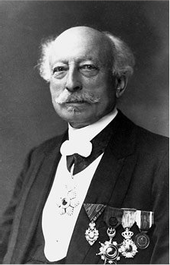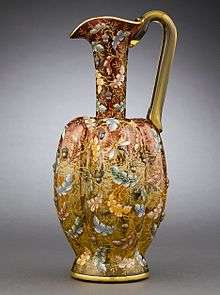Moser (glass company)
Moser a.s. is a luxury glass manufacturer based in Karlovy Vary, Czech Republic, previously Karlsbad in Bohemia, Austria-Hungary. The company is known for manufacturing stemware, decorative glassware (such as vases, ashtray, candlestick), glass gifts and various art engravings. Moser is one of the most collected of 20th century decorative glass[1] and has been used everywhere from palaces to local restaurants.[2] From its beginnings in 1857, as a polishing and engraving workshop, it developed into a lead-free glass manufacturer lasting through the 20th century until the present.
History



The original company of Ludwig Moser & Söhne, founded in 1857 by Ludwig Moser in Karlovy Vary, was a glass workshop initially devoted to polishing and engraving blank glass pieces;[3] only later did the company begin designing and making its own art glass products.[4] Engraving blanks, from Loetz, Meyr's Neffe and Harrachov was performed by the workshop in the early years.[5] At the Vienna International Exhibition of 1873 he was awarded a medal for merit; that same year he was appointed the exclusive supplier of glass to the Emperor Franz Joseph I.[6] He would win numerous other awards in the coming years, including medals at the World Exhibitions in Paris in 1879, 1889 and 1900, and the World Exhibition in Chicago in 1893.[6] Ludwig took over a glass factory in Meierhofen bei Karlsbad in 1893 to create a full service glassworks employing 400 people under the name of Karlsbaderglasindustrie Gesellschaft Ludwig Moser & Söhne where his sons Gustav and Rudolf also worked.[3]
In 1904 Moser received a warrant to supply the Imperial Court of the Emperor of Austria and four years later became supplier to Edward VII.[7] In 1915 the company exhibited at the Panama-Pacific International Exposition and was again awarded a medal, which Louis Comfort Tiffany and Charles Tuthill thought well deserved due to the outstanding quality of the hot glass applied decorations on coloured Bohemian glass.[8] Art Nouveau glass pieces were produced Moser with surface decoration with natural themes and simple cameo glass. They also used the Eckentiefgravur technique employing a sharp angular body deeply cut in the form of intaglio flowers.[5]
Following the death of his father in 1916, Leo Moser took over the direction and the company expanded significantly resulting in their recognition by a Grand Prize award at the Paris International Exhibition of Decorative Art in 1925. They also exhibited in London, Belgium, Italy and Vienna.[2] The depression of the early 1930s exacted its toll, reducing its staff to 240, eventually Leo resigned from the company in 1932. Later, having sold their company shares in the company in 1938, they fled the county after areas of Czechoslovakia were annexed.[9] The city of Karlovy Vary was occupied by Nazi Germany in 1938 after the Munich Agreement and the family fled the country during this anti-Semitic period. Because of its international reputation, the company was able to retain some independence during the communist era while the rest of the Czech glass industry was nationalised in 1948.[4][10]
The Art Nouveau designs of heavily engraved lilies and the Fipop series from c1914 were some of the most notable pieces. Several cheaper lower quality derivatives of the Fipop designs were produced by other companies and between 1927 and 1933 two American glassmakers made copies calling them Woodland and Deerwood.[4] Moser was one of the few Czechoslovakian glassmakers to sign their pieces.[11]
King of Glass, Glass of Kings
The slogan King of Glass, Glass of Kings is associated with the company because of its famous clientele who, in addition to Edward VII and the Austrian Imperial Court, include such people as Pope Pius XI, the Turkish sultan Abdul Hamid II.,[9] the king Luís I of Portugal and his wife, Maria Pia of Savoy.[12]
Present day

Ludwig Moser developed a lead-free sodium-potassium glass that is more ecologically friendly than lead glass yet is extremely hard; it remains the basis of their products.[13] Moser still produces some of its classic Fipop designs.[4] A factory museum shows the 150-year story of the company in more than 2,000 pieces on display supplemented by documentaries and audio guides.[14] Besides having four retail outlets in the Czech Republic, two in Prague and two in the company's hometown Karlovy Vary,[15] Moser has a worldwide network of retailers.[16] Moser's US distribution company was established in Northern Virginia in 1957.[17]
See also
References and sources
- Notes
- ↑ McConnell (2006), pps. 14–15
- 1 2 Luther (2002), p. 124
- 1 2 Arwas (1996) p. 50
- 1 2 3 4 McConnell (2006), pps. 54–55
- 1 2 "Collectors field guide to glass". Mini Encyclopedia. Style and Design. 2006. Retrieved 2008-12-26.
- 1 2 "Timeline of Moser Glassworks". Moser. Retrieved 2016-06-29.
- ↑ "History of Moser and its crystal glass". Moser. 2011. Retrieved 2011-05-19.
- ↑ Crofford (2001), p. 170
- 1 2 Singer, Joshua (2007-11-13). "Moser: 'King of glass' celebrates 150 years of luxury glass production". Radio Praha. Retrieved 2009-01-09.
- ↑ McConnell (2006), p. 59
- ↑ McConnell (2006), p. 32
- ↑ http://www.palacioajuda.pt/pt-PT/coleccoes/vidro/ContentDetail.aspx?id=330
- ↑ "Development of new products". Moser. 2011. Retrieved 2011-05-19.
- ↑ "Glass Museum". Moser. 2014. Retrieved 2014-12-26.
- ↑ "Moser shops in Czech Republic". Moser. 2011. Retrieved 2011-05-19.
- ↑ "Moser shops". Moser. 2011. Retrieved 2011-05-19.
- ↑ "About Us". Moser USA. Archived from the original on 2008-01-07. Retrieved 2008-01-16.
- Sources
- Arwas, Victor; Newell, Susan (1996). The Art of Glass: Art Nouveau to Art Deco. Windsor, Berks, England: Andreas Papadakis Publisher. ISBN 978-1-901092-00-4.
- Crofford, Maurice (2001). The Rich Cut Glass of Charles Guernsey Tuthill. College Station: Texas: Texas A & M University Press. ISBN 978-1-58544-148-8.
- Luther, Louise (2002). Miller's Art Glass: How to Compare & Value. London: Octopus. ISBN 978-1-84000-542-4.
- McConnell, Andy (2006). Miller's 20th-Century Glass. London: Miller's. ISBN 978-1-84533-099-6.
External links
| Wikimedia Commons has media related to Moser (glass company). |